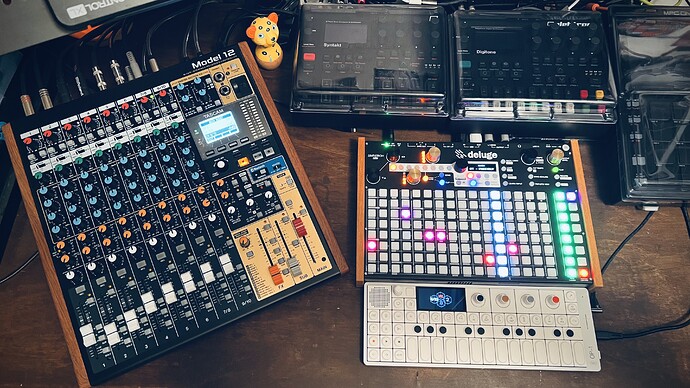It would be pretty weird for it to be defective in a way that both channels of the SUB OUT across all strips are 100% dead. I’d expect either the L or the R to go, or for it to be crackly, or just strip 3 or something.
If you’re still not finding what’s wrong, the best way to troubleshoot signal path:
- Make sure LOW CUT and INST are disengaged (up) and that the MAIN and SUB faders are all the way down.
- Plug a thing in the IN port of a strip.
- Play the thing and turn the GAIN (red pot) up slowly until the green LED next to it illuminates. Keep going until it starts flashing red, then bring it down a bit until it’s consistently green again.
- If the green LED never lights, there’s a problem between your source and the Model 12. Bad cable? Balanced signal canceling? Level of instrument not turned up?
- Make sure MODE is switched to LIVE
- Go to the METR screen to see your meters.
- Play something. You should see the meter for your channel bump (if you’re using strip 9/10, it’s on the second page. Don’t forget to page over to it)
- If you don’t see levels, there’s something weird between the back panel and the mixer. This is usually a routing thing (mode is set to PC instead of live. Mode is set to MTR and strip is not armed, etc)
- Disengage (up) MUTE, MAIN, and SOLO of your strip. Engage (down) SUB. Set the level fader to ~0db
- Disengage (up) MUTE and MAIN of the SUB section. Slowly bring up the SUB level fader until you hear signal over the SUB outs, or until you reach ~0db.
- If you’re not hearing anything over the sub outs at this point, there’s probably something wrong between the sub outs and your monitors. Cables? Monitor levels and power?
- We’re not getting signal over the SUB OUTs, but we can still check to see if we’re getting signal on the SUB bus. Engage (down) the SUB’s MAIN.
- Disengage (up) the MUTE in the MAIN section. Play while slowly bringing up the MAIN level fader. Watch the MAIN meter to the right of the LCD screen. It should start to bump.
- If the MAIN meter never illuminates, there’s a problem between the strip and the SUB bus. I’m honestly not sure what this could be, as this should be all DSP at this point, but maybe could be some uncommon routing option in some deep menu somewhere? It might be worth doing a factory reset to make sure everything is as normal as possible?
If you’ve gone through all this and no joy, then unplug from whatever strip you were testing, plug in a different one, and repeat these steps from the top to rule out it being a single broken port or dodgy switch on a specific strip.
If you’ve done this on multiple strips and still no joy, I’m out of ideas 
 . My Model 12 has actually been behaving itself lately and the start up issue has been very rare, hoping it stays this way of course. But I have bookmarked your post incase I do need this in the future. Thanks again, appreciate you sharing this.
. My Model 12 has actually been behaving itself lately and the start up issue has been very rare, hoping it stays this way of course. But I have bookmarked your post incase I do need this in the future. Thanks again, appreciate you sharing this.
